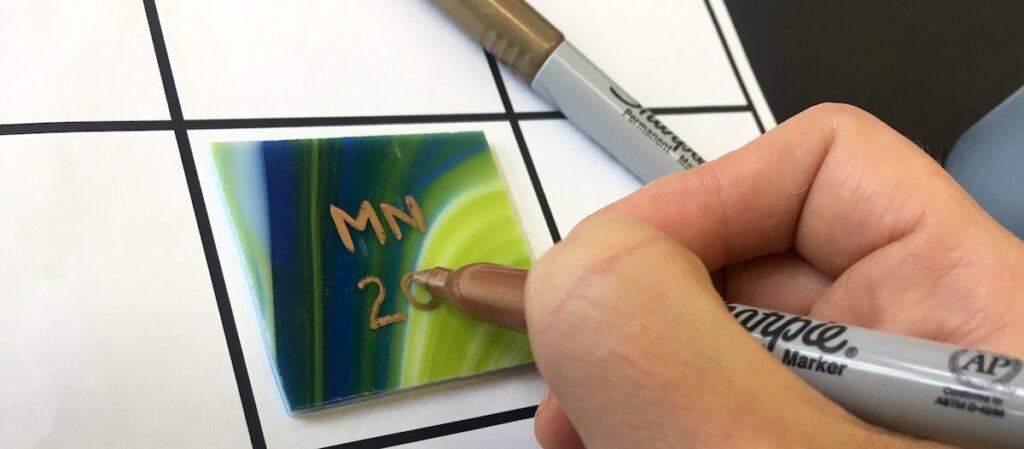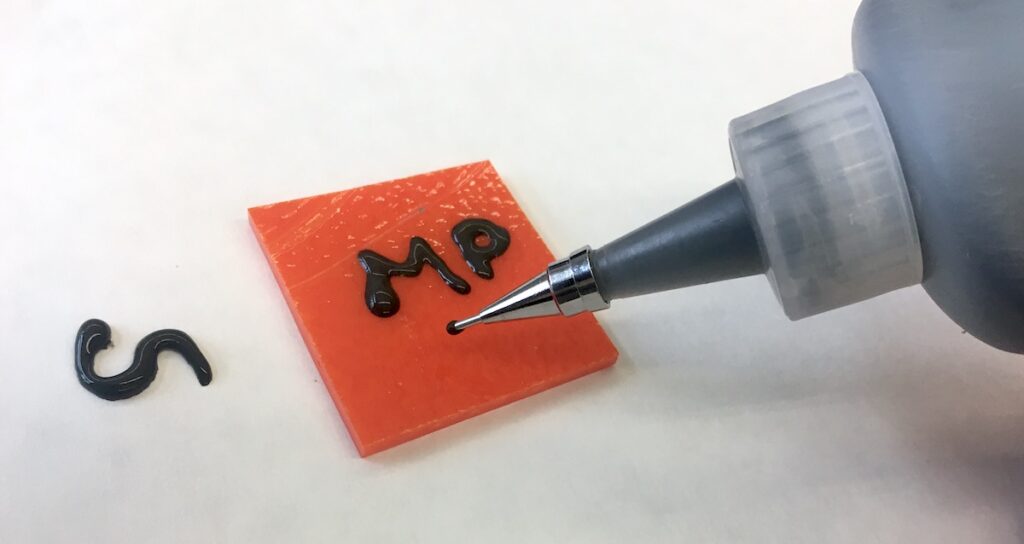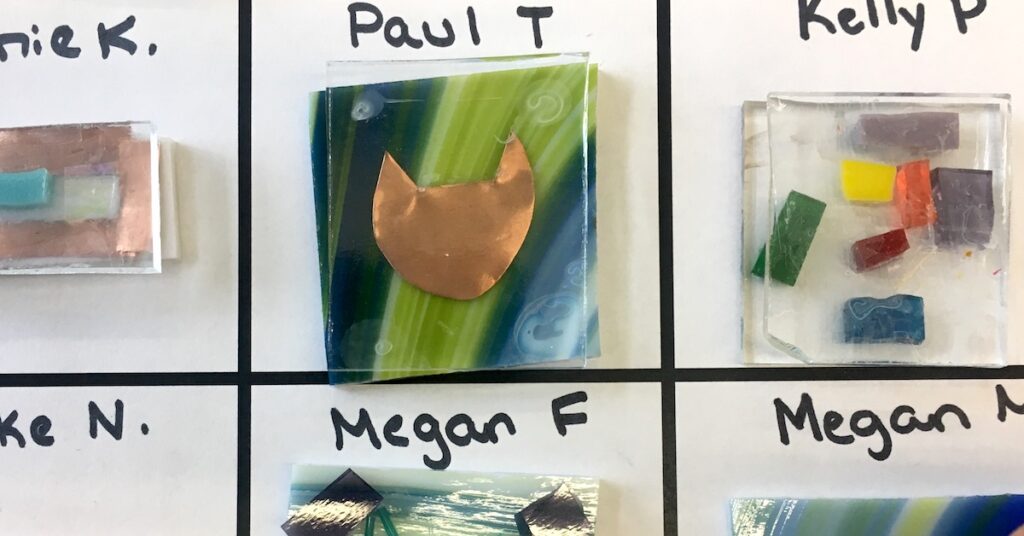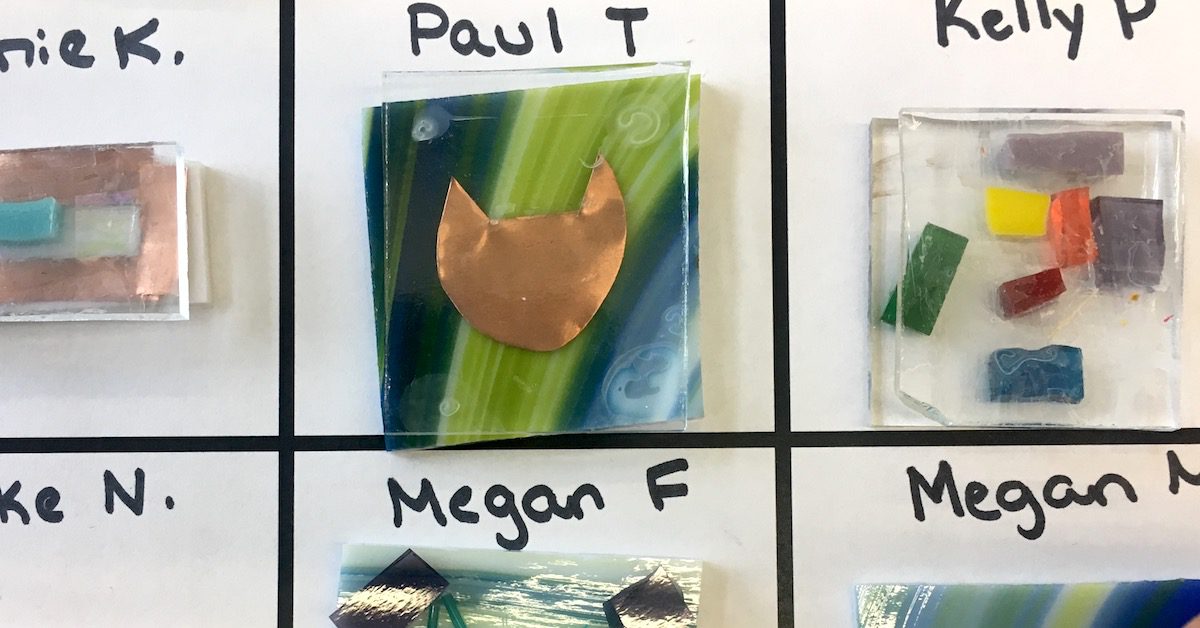What’s better than sparkle with a little bit of danger? Fused glass is an engaging medium for any student. Unfortunately, finding a way to label glasswork that won’t burn off during firing can be really tricky. This is also true of thin or small ceramics pieces where carving in students’ name isn’t feasible. Without a good system, it’s difficult to get the correct work back to students.
Here are 3 tried and true ways to label work so you won’t be left guessing.
1. Use Metallic Markers on Glass

Use a metallic marker, like a metallic Sharpie or a metallic paint pen, to write student names on the back of glass pieces. Unlike regular ink, metallic ink resists the heat of fuse firings.
Pros:
This option is the easiest to manage. Metallic markers dry almost immediately and older students can even label artwork themselves.
Cons:
The marks made by metallic markers, like Sharpies, can fade or disappear, especially on white or opaque glass colors. Make sure you use brand new markers and keep them capped and away from water. Although paint pens are messier, they give more consistent results.
Here are a few options that work well:
2. Use Products Specifically Made for the Job

Glass enamel paint was created to make permanent, visible marks on fused glass. Use a glass enamel marker or a bottle of enamel with a fine-line tip to label student work before you fire it. It also comes in a pen form for easier application and cleanup. Here are a few types to try:
There are also specialty products for ceramics. Try underglaze pencils, underglaze ink pads, or precision applicators to clearly and permanently label clay projects through both bisque and glaze firings.
Pros:
These options are the clearest and most permanent because they’re specifically made for this purpose. If you make a mistake, you can easily wipe them off and try again.
Cons:
Glass paint and underglaze are wet! This means work will need to be stored upside down until it has dried. Be aware glass paint takes longer to dry than underglaze. In addition, you’ll want to practice with your specialty products prior to writing on pieces to prevent blobs. And, be sure to shake liquids well before applying!
3. Draw a Grid

This technique doesn’t mark the glass or ceramic pieces at all and requires some organization and planning. Use a paper grid to keep student work organized before and after firings. The grid can be used on its own or as a secondary measure in case writing fades during the firing process.
Here’s how to do it.
- Draw a grid on a piece of paper and make extra copies for each class.
- Label each box with a student’s name and room number. As students complete work, have them place their piece in the spaces labeled with their names.
- Take a picture! This helps when it’s time to unload pieces in case you get confused. (It’s also valuable evidence when a student doesn’t recognize their work!)
- Load pieces into the kiln in the same pattern as the grid.
- After firing, return pieces to the grid for students to label with a regular Sharpie and take home.
Pros:
This option is the best for clear or transparent glasswork or tiny ceramics pieces and doesn’t require any specialty materials.
Cons:
Students sometimes don’t recognize their work after it’s fired. This is especially true of glass pieces where things may shift and melt. Artwork that is not labeled straight out of the kiln could go unclaimed.
Any time something comes out of the kiln it’s an “ooooh, ahhhhhh” experience for students. Having a student lose track of their artwork or get the wrong piece back can ruin the experience. Now that you know how to label and organize, don’t be afraid to try it!
If you’re interested in trying glass fusing in your classroom, be sure to check out these other articles:
How do you label fused glass in your classroom or studio?
What secrets, tips, and tricks can you share about teaching glass fusing?
Magazine articles and podcasts are opinions of professional education contributors and do not necessarily represent the position of the Art of Education University (AOEU) or its academic offerings. Contributors use terms in the way they are most often talked about in the scope of their educational experiences.





